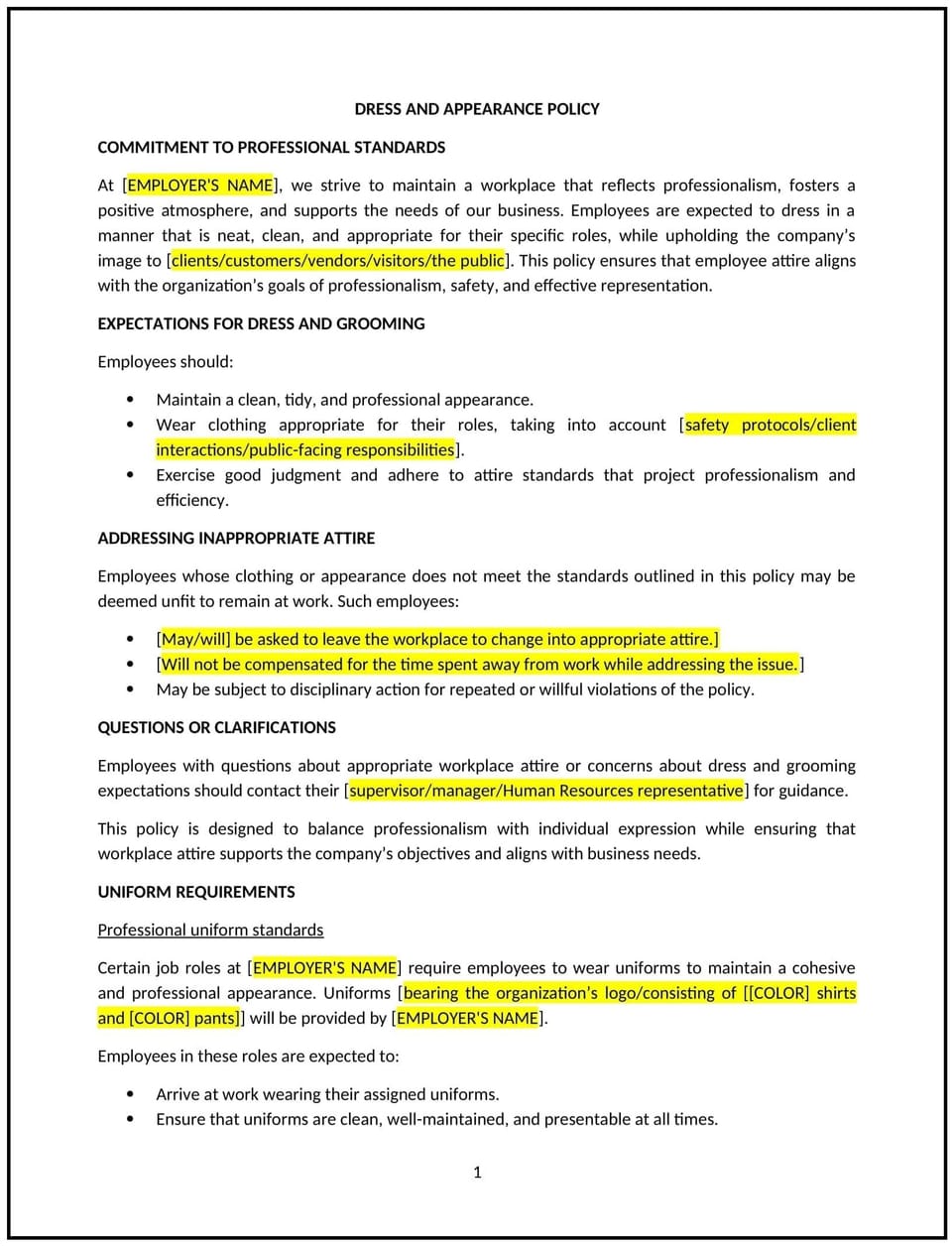Dress and appearance policy (Kentucky): Free template

Dress and appearance policy (Kentucky)
A dress and appearance policy provides Kentucky businesses with guidelines for employee attire and grooming standards to ensure a professional, safe, and respectful work environment. This policy outlines expectations for appearance based on the nature of the business, customer interactions, and safety requirements.
By implementing this policy, businesses can promote a professional image, enhance workplace safety, and foster a sense of unity and inclusivity among employees.
How to use this dress and appearance policy (Kentucky)
- Define appropriate attire: Clearly outline the types of clothing that are acceptable in the workplace, specifying requirements for business casual, formal, or uniform dress codes, depending on the industry.
- Address grooming standards: Include expectations for grooming and hygiene, such as hair length, facial hair, and personal cleanliness.
- Specify safety-related requirements: For certain roles, define attire that meets safety regulations, including uniforms, protective gear, or closed-toe shoes for environments like manufacturing or construction.
- Accommodate cultural and religious practices: Provide guidelines for accommodating employees’ cultural or religious dress requirements, such as headscarves, turbans, or other attire.
- Include flexibility for remote work: If applicable, clarify the dress code for employees working remotely or in non-client-facing roles.
- Promote personal expression: Encourage employees to express their individuality within the context of maintaining a professional appearance and aligning with company standards.
- Set consequences for violations: Outline the potential actions for non-compliance, such as informal discussions, formal warnings, or corrective actions.
Benefits of using this dress and appearance policy (Kentucky)
This policy offers several advantages for Kentucky businesses:
- Promotes professionalism: Establishes a clear standard of dress to present a professional image to clients, customers, and colleagues.
- Enhances workplace safety: Ensures that employees wear appropriate clothing and gear to meet safety requirements and reduce the risk of accidents.
- Fosters inclusivity: Provides guidelines for accommodating diverse cultural and religious practices, promoting respect and inclusiveness.
- Improves employee morale: Clear dress standards can create a consistent and cohesive work environment, enhancing team unity.
- Supports compliance: Ensures businesses meet industry-specific regulations and standards for appearance and attire.
Tips for using this dress and appearance policy (Kentucky)
- Communicate the policy: Share the policy during onboarding and include it in the employee handbook to ensure all employees understand expectations.
- Be consistent: Apply the policy consistently across all employees while allowing for flexibility when necessary to accommodate individual needs.
- Monitor compliance: Regularly review employee attire to ensure it aligns with the policy and address violations promptly and respectfully.
- Encourage inclusivity: Create an environment where employees feel comfortable expressing their individuality within the boundaries of the company’s dress code.
- Review periodically: Update the policy as needed to reflect changes in workplace norms, safety standards, or Kentucky laws.
Q: What is the purpose of a dress and appearance policy?
A: The policy sets expectations for employee attire and grooming to maintain professionalism, workplace safety, and inclusivity.
Q: What types of attire are acceptable in the workplace?
A: The policy outlines acceptable attire based on the business’s dress code, such as business casual, formal, or specific uniform requirements for certain roles.
Q: Are there any grooming expectations?
A: Yes, employees are expected to maintain a neat and professional appearance, with guidelines for grooming and hygiene, such as hair length and cleanliness.
Q: How does the policy accommodate cultural or religious attire?
A: The policy provides flexibility for employees to wear attire related to their cultural or religious practices, such as headscarves or turbans, while maintaining a professional image.
Q: What is the policy for remote employees?
A: The dress code for remote employees may be more flexible, but the policy provides guidelines to ensure that employees still maintain a professional appearance during virtual meetings.
Q: What happens if an employee does not comply with the policy?
A: Non-compliance may result in informal discussions, formal warnings, or corrective actions, depending on the nature of the violation.
Q: How often should the dress and appearance policy be reviewed?
A: The policy should be reviewed regularly, at least annually, to ensure it remains relevant and in line with changes in workplace norms or Kentucky laws.
This article contains general legal information and does not contain legal advice. Cobrief is not a law firm or a substitute for an attorney or law firm. The law is complex and changes often. For legal advice, please ask a lawyer.


